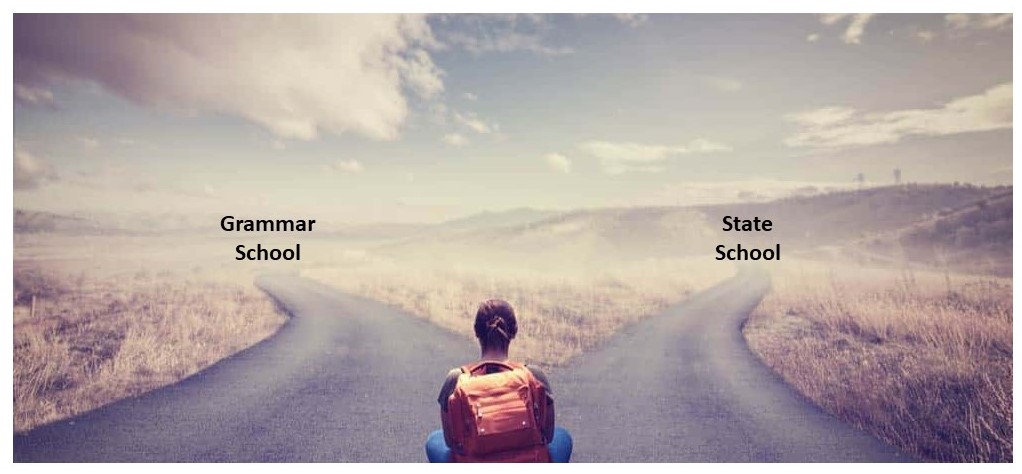

Transition from primary to secondary school can be a time of anxiety for parents. Determining ideal secondary school between grammar and state schools; which one is right for your child, can be daunting. It helps to be clearer on the available options to determine a better choice for education.
Let us look at what these schools offer and distinguish multiple elements between these two types of schools.
Admission Criteria
Grammar schools select their students by means of an exam called 11 plus test to access a student's academic ability. This test is taken by students in Year 6, the last year of their primary school and are at least 11 years old, and hence the name 11 plus.
The 11 plus exam consists of: Maths, Verbal reasoning, Non-verbal reasoning, English Comprehension, punctuation and grammar and Creative writing. Students are expected to achieve a certain score to secure their place at a grammar school. The competition to get into these Grammar Schools is usually fierce due to limited number of schools and seats. It should also be noted that passing the 11 plus exam does not guarantee an admission into Grammar School. They may use oversubscription criteria to restrict admission if number of students passing the exam is greater than the seats they have.
State schools are non-selective comprehensive schools in which children with all abilities and aptitudes are accepted and taught together without any entrance exam.
Preparing for Entrance
Even though the Grammar Schools are not as many, the competition to get into one is very tough. As a result, an intensive preparation is required by students to clear the 11 plus exams. There are many websites such as 11plusexampapers.co.uk and 11plusguide.co.uk that provide good resources for the preparation of 11 plus exam. These websites also offer a good collections of practice tests by sections and topics. Also, a comprehensive information on test formats and exam process.
State Schools, on the other hand, do not require clearing such external tests for admission and follow their own application process based on the criteria that could include distance from school, siblings already in that school etc.
Accessibility (Catchment Area)
Most Grammar School admit students by ranking them first by their 11 plus score and then by their admission criteria one of which could be the distance they live from school. If you are targeting for an admission to a Grammar School, it may require you moving into that area and as close to the school as possible.
State Schools may use similar criteria generally set by the schools themselves or their local council. However, a choice to enter up to 6 schools is given in the order of preference.
Funding
Grammar and State Schools both are state-funded, i.e., they receive funding through their local authority or directly from the government. Majority of the State Schools are overseen by local education authorities. Grammar Schools can be run by the local authority, a foundation body or an academy trust, though most Grammar Schools now have the academy status giving them more flexibility on teaching and curriculum.
Curriculum
Both Grammar as well as State schools follow the National Curriculum where equal emphasis is given to academic subjects. Similarly, both types of school offer Physics, Chemistry and Biology as separate subjects whereas some may offer Combined Science as well. Grammar Schools may also have greater flexibility on their curriculum if they have an academy status.
Learning Tools
Both the schools have good funding from the govt to modernize the teaching and learning aids. It has been observed that grammar schools utilize this funding for creating more academic resources whereas State school use it for modern equipment and technology e.g. interactive boards as an aid to the teaching methodology.
It has been observed that while State Schools have evolved to using the modern technology traditional, some Grammar Schools still use traditional technologies e.g., OHP.
Subject Choice
Both Grammar schools and State schools offer a broader choice as well as excellent facilities for non-core subjects e.g. Art & Design, Drama & Theater, Photography. It helps students to choose a subject as per their interest and preferences. Thus, making it easy for students to decide a course in University.
Transition
The Grammar Schools are known for their focus on academic achievements promoting core subjects. The students who get into Grammar Schools usually undergo intensive tutoring to clear 11 plus exam. While most of these students can be expected to adapt to the demand of Grammar Schools to maintain higher academic qualifications throughout the secondary school term, it can be challenging for some to constantly maintain their academic performance.
The State Schools accepts all students irrespective of their aptitude or academic potential. The learning pace is designed to accommodate students of all abilities and so is generally relaxed.
University Admissions
The influence of schools on admissions to top universities cannot be denied. Some schools provide excellent guidance and support to students in preparing their university applications. Though this is irrespective of Grammar or State Schools, it varies school to school.
According to data published by Varsity (source - varsity.co.uk), looking at 5 years of Cambridge university admissions statistics, it has been revealed that between 2014 and 2019, 48% applicants came from State Schools compared to 20% who attended Grammar Schools at GCSE or A Level.
Analyzing all Cambridge acceptance over this period shows that 40% acceptance belong to students came from State Schools to 22.6% who attended Grammar School at GCSE or A Level.
It can be inferred that attending Grammar Schools cannot be considered a firm indicator of getting admission to a top university.
Final Word
There are only 163 Grammar Schools in England out of total about 3113 State Secondary Schools. They are also not distributed evenly around the country and so, much will depend on where you live. If you bet on Grammar School for your child's education, the preparations have to start much ahead of their 11 plus exams.
At the same time, the State schools have seen progressive improvement in their results over last few years and should not be considered as academically lacking.
In the end, the choice between Grammar and State school is a personal decision and should consider academic potential and future career prospect each of them provides. Recently few academies have come up with better teaching facilities and academic talent. Its worth to look at while comparing Grammar and state school.

